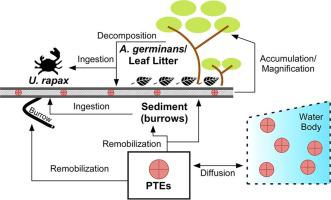Ecological Indicators ( IF 7.0 ) Pub Date : 2020-10-12 , DOI: 10.1016/j.ecolind.2020.107038 Michael Martínez-Colón , Henry Alegría , Ashley Huber , Hatice Kubra-Gul , Perihan Kurt-Karakus

|
In southern Puerto Rico along the coastline bordering the Jobos Bay National Estuarine Research Reserve, environmental encroachment has exposed mangrove forest to different sources of pollution. Potentially toxic element concentrations from the F1Tess (exchangeable), F4Tess (oxidizable), mangrove leaf litter (MLL), and fiddler crab whole body soft tissue were analyzed to assess the fate and transport of pollutants from the environment and its transition into flora-fauna via trophic transfer. Geo-accumulation factor values suggest the bay has experienced limited to no pollution when combining the concentrations of potentially toxic elements extracted from the F1Tess and F4Tess sediment fractions. These geochemical sedimentary compartments are considered “bioavailable” to flora-fauna as evidenced by the bioaccumulated Cd-Ba-V-Cu-Zn-As-Se in the leaf litter of the black mangrove Avicennia germinans and in the fiddler crab Uca rapax. The biota-sediment accumulation factor (F1Tess + F4Tess) demonstrated that Uca rapax behave like a de-concentrator for most pollutants and as a macro-concentrator for Cu-As, while the bioconcentration factors identified only Cu-As-Se as being actively bioaccumulated in the fiddler crabs. Of all the potentially toxic elements studied, As is the only one to be biomagnified via sediment-Avicennia germinans leaf litter-Uca rapax food chain. An unexpected find of this study was that the excavated sediment “pellets” by Uca rapax contained up to 4x the concentrations of Cd-Ba-V-Cr-Co-Ni-Cu-Zn-As-Se when compared to the F1Tess sediment fraction from the surface, thus suggesting a variable redox boundary within the fiddler crab’s burrow.
中文翻译:

生物蓄积和潜在毒性元素(PTE)的生物放大作用:Avicennia细菌-波多黎各Jobos湾的Uca rapax营养传递故事
在波多黎各南部,沿着与Jobos湾国家河口研究保护区接壤的海岸线,环境侵占使红树林暴露于不同的污染源。分析了F1 Tess(可交换),F4 Tess(可氧化),红树林凋落物(MLL)和Fiddler蟹全身软组织的潜在有毒元素浓度,以评估污染物从环境到环境的迁移和迁移以及向环境的过渡-通过营养转移的动物。地理积累因子值表明,结合从F1 Tess和F4 Tess提取的潜在有毒元素的浓度,海湾几乎没有受到污染沉积物部分。这些地球化学沉积区室被认为是动植物区系“生物可利用的”,这在黑红树林Avicennia菌种的叶子凋落物和提琴蟹Uca rapax中的生物富集的Cd-Ba-V-Cu-Zn-As-Se得以证明。生物沉积物累积因子(F1 Tess + F4 Tess)表明,Uca rapax的行为就像大多数污染物的去浓缩剂,还是Cu-As的大型浓缩剂,而生物富集因子仅将Cu-As-Se视为活跃在小提琴蟹中的生物积累。在研究的所有潜在毒性元素中,砷是唯一可以通过沉积物进行生物放大的元素-Avicennia菌种叶子凋落物-Uca rapax食物链。这项研究的意外发现是,与F1 Tess沉积物相比,Uca rapax挖掘出的沉积物“球团”所含Cd-Ba-V-Cr-Co-Ni-Cu-Zn-As-Se的浓度高达4倍。从表面分离出一小部分,因此表明提琴蟹的洞穴内氧化还原边界可变。











































 京公网安备 11010802027423号
京公网安备 11010802027423号